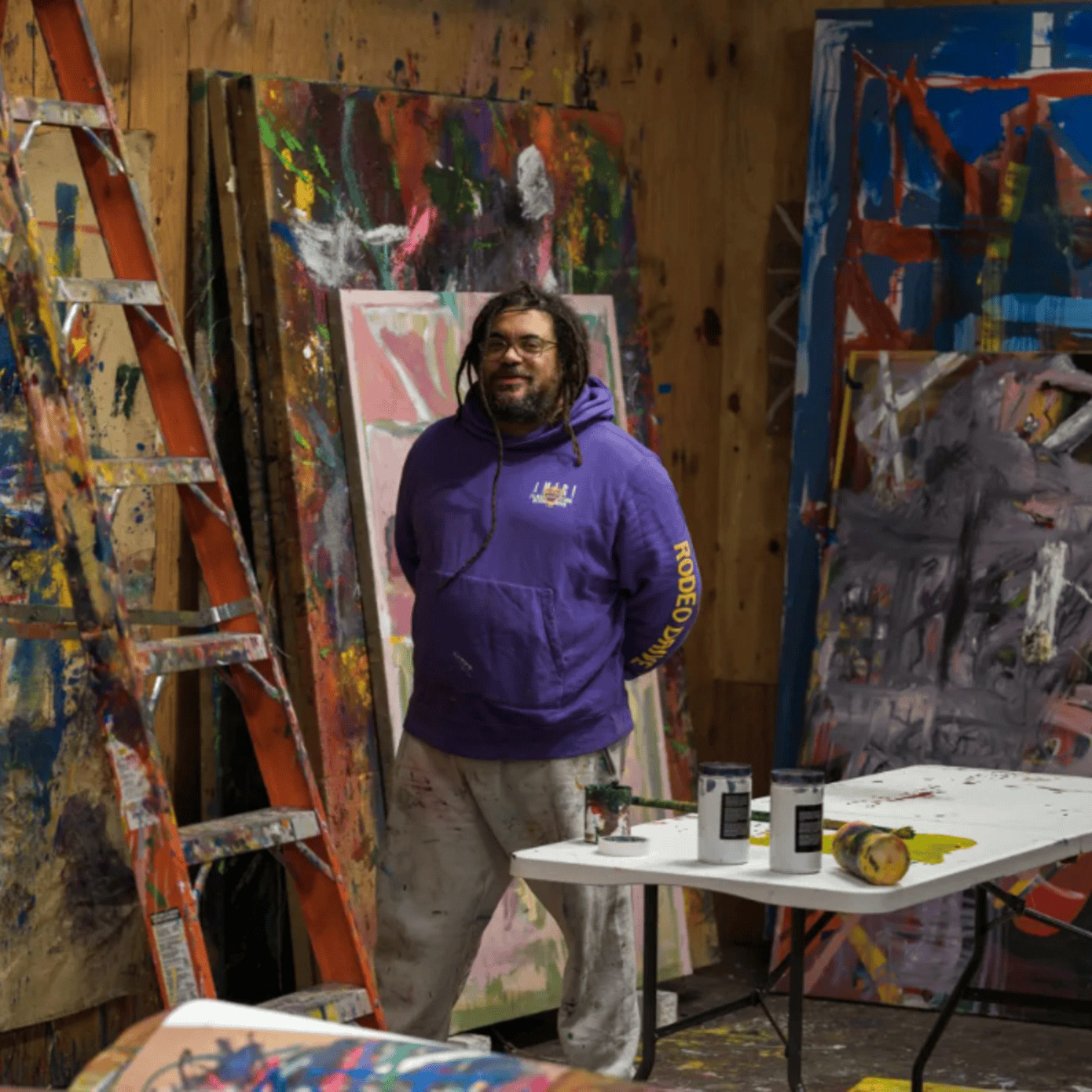
The Los Angeles–based painter and performance artist Gracie DeVito will be the first to admit that she’s been blessed with an enviable lockdown scenario. And not just because her pod includes her parents, actors and national treasures Rhea Perlman and Danny DeVito, along with her husband and fellow painter, Andy Giannakakis, and her younger brother, Jake, and older sister, Lucy, who are both, like their folks, in “the Biz.” This clan of accomplished artists also seems to truly enjoy one another’s company, and there’s a sense of creative cross-pollination that means even a family dinner is an opportunity to enrich their respective work. All are admittedly eager for a return to normalcy, but see this renewed intimacy as a definite silver lining.
Somewhat more bittersweet was the fact that Gracie’s show of paintings had just opened at LA’s Overduin & Co. when everything shut down. This meant that the work remained on the walls far longer than planned, just sitting “alone on Sunset Boulevard,” as she wistfully recalls. But wrapping up this body of work at this particular moment did enable Gracie to clear both physical and psychic space, leading to an especially fertile creative period in her studio that was only heightened by being “quarantined with fellow artists,” as she puts it.
Of course, this creative interplay began long before COVID hit. “[My parents] were really great at including [my siblings and me] in their work,” she says, “and put in place this philosophy about how to be an artist and then also not really separate that from your day-to-day life.” Gracie has also drawn upon her parents’ complementary modes of expression to help develop her own voice. She describes her mother’s dominant artistic mode as “lunatic, in the best sense of the word... My mom would express things through voice and movement, and also [could have] quite childlike responses to things, which kept you very energized.” While her dad “was kind of more like this like Zen storyteller monk who would make sure you were seeing things from every angle, and breathing in and out.” Put another way, “Dad’s more German expressionist mixed with Goya, and mom’s like this cartoon,” she adds with a laugh. And the blend is evident in Gracie’s paintings, which are somehow both meditative and boisterous. “Baby Gracie” first revealed this penchant for mashing up incongruous ingredients via early avant-garde baking experiments, Rhea reminisces, earning an affectionate eye roll from adult Gracie. Their profiler, however, is grateful for this quintessential glimpse into the artist’s formative years.

In contrast to their children, Danny and Rhea’s own artistic awakenings required going a bit more against the grain. They both admitted facing some initial skepticism from their parents regarding their chosen careers. Rhea’s father, Philip Perlman, couldn’t have been too opposed, however, because he went on to become a working actor himself, and it was his future son-in-law who gave him his first break. It all started early in the couple’s courtship, Danny recounts, when Phil revealed his very specific desire to deliver the line “dinner is served” on camera. Happily, Danny was already in a position to make things happen. Assorted small roles followed for Phil, including appearing regularly with his daughter on Cheers.
There is a pleasing symmetry to Rhea and Danny passing on their artistic inclinations bidirectionally, and it reveals the infectious joy they’ve found in their lives’ work, versus some kind of deliberate conditioning of their children to follow in their footsteps. “There was no pressure whatsoever. It was more like they were super excited about whatever we were doing,” Gracie professes. And speaking of bidirectional influence, Danny and Rhea credit Gracie with almost everything they know about contemporary art today. At Brown and then CalArts, Gracie learned to ground her natural (and nurtured) creative impulses in an art-historical context, and she brought her education home. “Gracie became our art teacher,” says Danny, adding that when she took them to Chelsea for the first time, they hadn’t even known about the neighborhood’s galleries. They loved it, and continue to be Gracie’s eager pupils.

But life in the DeVito-Perlman pod isn’t all unbridled creative expression. Where there’s art, there is often commerce, but thankfully Gracie’s adjacency to show business has helped prepare her for the world of dealers and collectors. She calls the two industries “similar machines” and observes that she and her parents, in their respective fields, are facing similar technological transformations meant to maximize profits. This can create further mediation between artist and audience, often without consultation of the artist. And the pandemic has only hastened these developments. Gracie singled out Warner Brothers’ recent decision to release movies directly onto their streaming platform, HBO Max, in lieu of the traditional theatrical wide release. Meanwhile, visual art is being propagated, sold and consumed via increasingly tech-driven means, like this entire year’s worth of virtual fairs. Gracie and her parents don’t see this as inherently bad per se. It’s just that, says Gracie, “Artists have to feel out how they are being represented in the age of tech capitalism and make sure it still feels right.”
So, yes, 2020 has been one big curveball for the DeVito-Perlmans. The art market, like almost everything else, is in dramatic flux, and film and theater productions are only starting to ramp back up. But while most of us occupy a less rarefied stratum than this particular family of creatives, we might still try to follow their example by wringing whatever insight we can from this bizarre, transitory moment, before the world changes completely, again.




